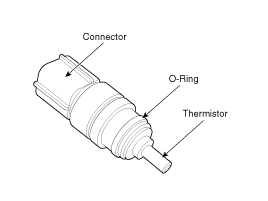 Kia Optima: Engine Coolant Temperature Sensor (ECTS). Description and Operation
Kia Optima: Engine Coolant Temperature Sensor (ECTS). Description and Operation
Description
Engine Coolant Temperature Sensor (ECTS) is located in the engine coolant passage of the cylinder head for detecting the engine coolant temperature. The ECTS uses a thermistor that changes resistance with the temperature.The electrical resistance of the ECTS decreases as the temperature increases, and increases as the temperature decreases. The reference +5V is supplied to the ECTS via a resistor in the ECM. That is, the resistor in the ECM and the thermistor in the ECTS are connected in series. When the resistance value of the thermistor in the ECTS changes according to the engine coolant temperature, the output voltage also changes.
During cold engine operation, the ECM increases the fuel injection duration and controls the ignition timing using the information of engine coolant temperature to avoid engine stalling and improve drivability.
 Intake Air Temperature Sensor (IATS). Repair procedures
Intake Air Temperature Sensor (IATS). Repair procedures
Inspection
1.
Turn the ignition switch OFF.
2.
Disconnect the IATS connector.
3.
Measure resistance between the IATS terminals 3 and
4.
...
 Engine Coolant Temperature Sensor (ECTS). Specifications
Engine Coolant Temperature Sensor (ECTS). Specifications
Specification
Temperature
Resistance (kΩ)
°C
°F
-40
-40
48.14
-20
-4
...
See also:
Components and Components Location
Component Location
1. Driver power window main switch
2. Passenger power window switch
3. Front window motor
4. Rear window motor
5. Rear window switch
...
Removal and Installation
1.
Disconnect the ignition coil connectors (A).
2.
Remove the ignition coils (A).
Tightening torque
:3.9 ~ 5.9N.m (0.4 ~ 0.6kgf.m, 2. ...
Inspection
Brake Booster
1.
Inspect the check valve in the
vacuum hose, intensifier and the connecting section.
...
